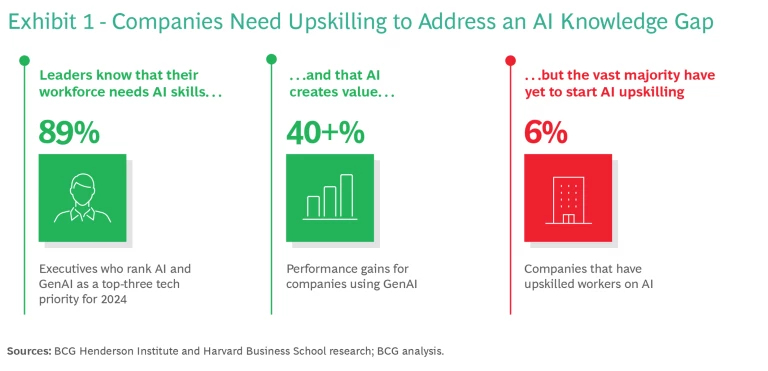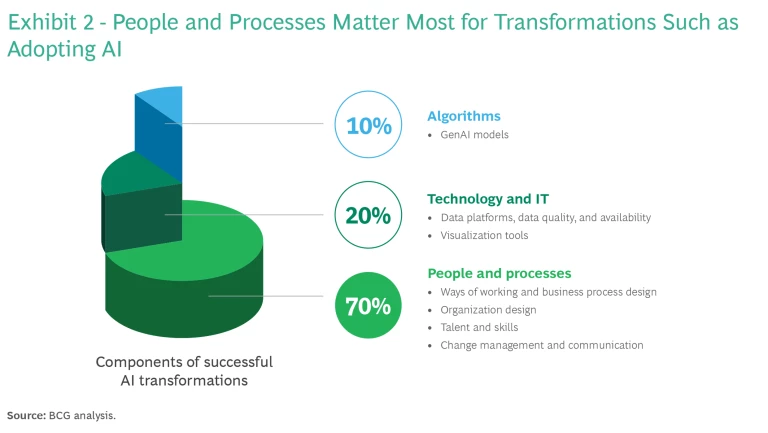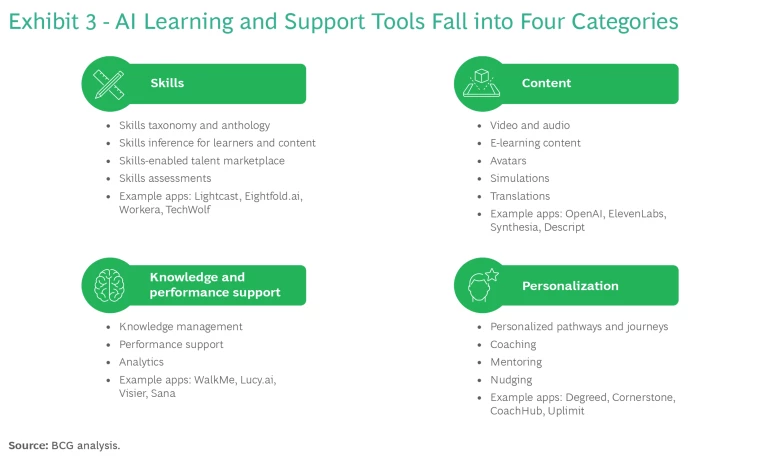The need for AI upskilling is clear. But upskilling is also a major bottleneck for companies that want to scale AI and GenAI across their organizations. Even though corporate leaders know it’s important, many have been slow to provide people with opportunities to learn the skills required to use it.
There’s an argument to be made for initiating AI upskilling sooner rather than later. Companies that invest in AI gain a competitive advantage through superior innovation and readiness for the unexpected. They also improve productivity and customer experience, and boost revenue.
But until now, it’s been unclear which approach to AI upskilling yields the biggest return on the twin investments of time and resources.
We decided to find out. We studied early adopters’ AI upskilling efforts, and ran AI upskilling workshops for thousands of executives to glean best practices. We also interviewed dozens of industry experts. We determined that the most effective approach incorporates five distinct actions. It starts with assessing what’s needed and putting systems in place to measure successful outcomes. It includes preparing people for change, building in incentives that appeal to their varied motivations to learn, and putting the C-suite at the forefront of the initiative. Finally, it means using AI to upskill people in AI.
Amid an AI-Inspired Sea Change, Upskilling Is Lagging
AI is ushering in a tsunami of change. Already, 80% of organizational leaders regularly use AI tools, according to a BCG global survey of 13,000 people.
Companies that don’t invest in AI capabilities tend to be more susceptible to disruption. BCG’s research on future-ready companies identified AI as one of six key attributes that help them withstand shocks and disruptions and exploit innovation for value-creating growth. These standouts outperform their peers across multiple financial and nonfinancial metrics.
The same research found that early adopters of GenAI use it to improve efficiencies, enhance customer experience, and boost revenue. For an organization with $20 billion in revenue, using GenAI leads to estimated additional profits of $500 million to $1 billion, with nearly a third of those gains coming in the first 18 months. Separate research by BCG Henderson Institute and Harvard Business School found that adopting AI leads to 40% higher quality and 25% faster output.
AI isn’t without risks, including risks associated with fairness and equity, privacy, accuracy, and security. To realize AI’s gains and minimize associated risks, companies must connect the technology to organizational change. Our experience and research indicate that adopting a structured approach to “deploy, reshape, and invent” AI-based processes and experiences throughout an organization yields high-impact results.
That’s where upskilling comes in. To succeed, organizations must upskill their workforce to understand and embrace AI.
But upskilling efforts are off to a slow start.
The vast majority of 1,400 C-suite executives whom BCG surveyed earlier this year ranked AI and GenAI among their three top technology priorities for 2024, but 66% expressed ambivalence or dissatisfaction with their progress. Close to the same number (62%) cited a shortage of talent and skills as their biggest challenge, ahead of unclear investment priorities (47%), and lack of a responsible AI strategy (42%). Only 6% said that they had already begun upskilling in a meaningful way. (See Exhibit 1.)

Lack of training extends to companies’ top echelon. Of the leaders we polled, 59% reported having limited or no confidence in their executive team’s proficiency in GenAI.
Five AI Upskilling Success Factors
Although the need for AI upskilling is well established, the approach that yields the greatest benefits remains unsettled.
To learn more, we performed quantitative and qualitative research, including studying best practices of organizations that have been quick to adopt AI. We gleaned additional best practices from collaborating with Google Cloud and ran more than 150 AI upskilling workshops for 3,000 executives who use Google Cloud. We also interviewed more than 50 human resources and learning and development industry leaders who are well-known talent development innovators.
Our analysis revealed five actions that organizations need to take to ensure successful AI upskilling.
1. Assess Needs and Measure Outcomes
Organizations that fall behind on skills training are apt to deploy a “watering can” approach to improving—launching learning programs that are undifferentiated, costly, and poorly aligned with overall strategy. A better approach is to launch an upskilling initiative predicated on an assessment of what’s needed and then to measure the outcomes it produces.
Assessing Need. In evaluating what’s needed, companies must determine the upskilling requirements of each specific workforce group. C-suite leaders need to define the organization’s AI vision and strategy and lead AI upskilling initiatives. Managers need to know how to build awareness among direct reports. Workers need to know how to use AI tools. The entire workforce needs to understand how the organization plans to integrate AI into operations and how work will get done.
The workshops that BCG and Google Cloud ran helped Fortune 1000 clients upskill their executive leadership teams on GenAI.
Prior to the workshop, Google Cloud assessed where each client was in the process of deploying GenAI in production. The company then used this information to tailor workshops to individual needs, develop the optimal industry-specific use cases, and identify the AI applications that would create the most value for each client’s business.
Once an organization has assessed its needs, it can evaluate and invest in the appropriate AI tools.
Measuring Outcomes. Assessing the effectiveness of AI upskilling and analyzing the return on learning investment (ROLI) can justify a company’s spending and guide future improvements.
To measure an upskilling program’s ROLI, we recommend using the Kirkpatrick method, which evaluates effectiveness on four levels:
- Level 1: Learning experience quality and program satisfaction, as gauged by conducting surveys of learners
- Level 2: Competency development, as measured by assessing learners’ post-upskilling abilities
- Level 3: Individual productivity gains and behavioral changes, as appraised by observing learners’ improved productivity—for example, in sales lead conversion or customer satisfaction—over time
- Level 4: Business outcomes
Business outcomes are the hardest to measure because when multiple factors change at the same time, it’s difficult to determine which caused a positive result. We recommend that organizations measure them by conducting A/B tests or pilots with control groups.
A retailer that we worked with used A/B testing as part of an upskilling initiative to make its chain of more than 500 stores more customer centric. The company determined key metrics by working backward from desired outcomes, including higher sales per square foot, stronger employee engagement, and improved feedback from customers. The company ran tests to analyze the effects of upskilling efforts in one group of stores against a control group of stores that had not implemented an upskilling program. By testing various upskilling methods and measuring their results, the retailer eventually implemented training that helped the workforce increase sales by 150 basis points, double employee engagement, and receive more positive comments from customers.
2. Prepare People for Change
Business or technology transformations such as adopting AI have three key components: people and processes, technology and IT, and algorithms. Of the three, the changes involving people and process are the most critical. (See Exhibit 2.)

For a transformation of any kind to succeed, people must be prepared. And a crucial part of preparing them for an AI transformation involves raising awareness of what’s going to happen within the three distinct groups in which people work:
- Individuals. AI represents a chance for people to work in new ways that make tasks easier, enhance productivity, and optimize workflow. For this to happen, people need to understand how AI tools automate routine tasks, provide data-driven insights, and support decision making. They need to understand how their roles may evolve as the organization deploys AI and GenAI.
- Teams. People need to recognize how the organization will be integrating AI into complex workflows and collaborations within and between teams. They need to see how teams will benefit from AI-based project management tools and how AI-run collaborative platforms will enhance communication and coordination, leading to greater innovation, streamlined processes, and better outcomes.
- Across the Organization. People need to comprehend how AI fits into the company’s culture and strategy, what effects AI may have on its operating model or business value, what potential pitfalls may accompany the transformation, and what guardrails may protect against them. To that end, the company must establish an organization-wide AI change management program to provide the entire workforce with a basic understanding of AI concepts and applications. By embedding AI into the fabric of the organization, the company can create a culture that supports continuous improvement, innovation, and equitable opportunities for employees to grow in their careers.
Organizations can raise awareness in multiple ways, including by running enterprise-wide communications campaigns and celebrating people when they successfully adopt AI to improve their personal productivity or automate tasks. Other awareness-building tools include AI hackathons, continuous improvement workshops, and safe spaces for experimenting with AI tools.
3. Unlock Employees’ Willingness to Learn
Part of AI upskilling consists of giving people a strong impetus to get on board with change and offering a psychological safety net so they don’t fear what’s to come.
Employees may not be keen to adopt AI skills. Instead of viewing AI as a tool that enhances their roles, they may see it as a threat that could displace them. They may have the impression that AI is complex and hard to understand, and so feel intimidated by it. For people without a technical background, the prospect of learning AI may be overwhelming, making them reluctant to take it on.
Discovering what motivates people can help a company shift their attitudes toward adopting AI skills. Some people are motivated by intrinsic incentives, such as an internal drive to improve or personal values. Others appreciate external incentives, such as earning a digital badge or recognition that could help them get ahead in their job. Providing people with autonomy and responsibility for their own upskilling journey can motivate them to engage in upskilling in a way that they enjoy. It can also transform them into AI ambassadors, with cutting-edge skills.
Making upskilling fun by turning it into a game is another way to persuade people to try something new, as are digital nudges, peer groups, and weaving learning into daily work. Removing barriers to learning and letting people choose how to learn can increase their openness to change.
Top leaders can offer a psychological safety net by making it clear that the purpose of AI is to enhance people’s roles and create new opportunities, not to replace jobs. Leaders can further motivate people by elevating an initiative’s visibility and ensuring that the company’s investment in it is sufficient to meet its upskilling goals. Contrarily, trying to do too much with too little can result in program failure and cause people to lose faith in the upskilling effort.
4. Make Adopting AI a C-Suite Priority
Efforts to raise awareness and train and motivate people can fizzle out if the C-suite doesn’t make adopting AI a top priority. Even at organizations with chief AI officers, the CEO and other C-level executives must function as AI’s top advocates and as AI upskilling champions. Top executives must have clear responsibilities for upskilling programs to drive adoption and realize anticipated impact and value. At the same time, organizations must centralize AI governance to avoid creating an every-department-for-itself mentality with regard to adoption and upskilling requirements.
The CEO and the leadership team can embrace the AI skills transformation by modeling desired behaviors and actively participating in AI initiatives. That level of commitment will cascade through the organization to foster a culture of continuous learning and innovation. The CEO should oversee the development of AI objectives and lead the effort to make them clear to the organization. The chief operating officer should ensure that AI use cases match business objectives and that the organization is implementing them with a minimum of obstacles. Top risk and information security executives should maintain proper controls to minimize risks.
At CMA CGM, a leading global shipping and logistics company, leaders from the top down participated in launching an AI skills accelerator program. CEO Rodolphe Saadé attended the launch event and further underscored the importance of upskilling in the company’s plans by regularly visiting training facilities to meet learners. Saadé also closely tracked the performance of the third-party upskilling providers that the company retained. Other C-suite leaders participated in AI upskilling sessions, answering questions and collecting possible use cases that learners created as part of their training. Senior managers upskilled with other learners, which helped the initiative cross business lines and functions. Getting early buy-in from key leaders helped foster a culture of continuous AI learning and promote AI adoption for innovation and efficiency at all levels.
Given how quickly the technology is evolving, AI upskilling will be an ongoing effort. Having C-suite support demonstrates to the rest of the organization the necessity of building upskilling muscle at every level.
5. Use AI for AI Upskilling
Upskilling that requires people to use AI on the job is an effective way to connect the dots between theoretical learning and practical application. We’ve found several methods that are effective for on-the-job AI upskilling.
Using AI Tools. Using AI to upskill people on AI will be unavoidable in the future to keep costs down and make learning impactful, scalable, customizable, and fast. New AI-based upskilling tools are emerging almost daily: more than 100 learning tools launched in 2023 and the first half of 2024, and the influx of new options shows no sign of stopping. Some tools have AI as their core function. Others use AI to support the application’s main function.

AI learning and support tools fall into four categories: skills, content, knowledge and performance support, and personalization. (See Exhibit 3.) Understanding where specific tools exist in this framework can help companies navigate what’s available, which in turn can help them implement upskilling initiatives faster and more efficiently.
The Network Effect. Embedding AI in daily tasks at all levels creates a network effect: the more people use and understand it, the more the entire organization gains in knowledge, innovation, and efficiency.
Companies can support the network effect in several ways:
- Center AI training around real-world projects.
- Offer sessions to teach individuals the AI tools they will be using in their roles, thereby creating ambassadors to propagate AI’s value across the organization.
- Use peer influence to amplify learning. In this regard, CMA CGM scheduled joint AI upskilling for employees from diverse geographies, business lines, levels, functions, and backgrounds to create synergies across company sectors.
A Tailored Approach. AI upskilling can be easier to digest when the organization customizes learning to match tangible business objectives and high-priority use cases. Whether the company orchestrates upskilling programs on its own or with outside help, it should adapt the training to its specific business context and embed hands-on learning into people’s daily tasks.
Building multiple complete customized AI upskilling training programs from scratch can be costly. A less expensive approach involves creating learning units for in-demand topics that trainers can pair with customized content in building-block fashion.
Putting AI Upskilling into Action
Upskilling people on AI must be a C-suite priority. To unlock the full potential of AI upskilling, organizations should keep the following considerations in mind.
Identify gaps, and tailor programs to fill them. When assessing the workforce's current skill level, identify specific gaps in AI competencies that customized training programs can address. Tailor programs to the needs of individuals, teams, and the organization. Collaborate with outside AI and upskilling experts to tap into high-quality resources and practical experiences.
Integrate upskilling into long-term strategic plans. Incorporating learning programs into broader strategies makes them more sustainable and increases the benefits that the organization will derive from them. Integrating training into strategy means creating well-defined career pathways for employees who acquire new AI skills, and recognizing and rewarding people who obtain them.
Establish internal AI centers of excellence. AI learning hubs can promote knowledge sharing, mentorships, and collaborative projects, all of which can help promulgate the application of AI across business functions. Embedding AI upskilling into the organizational culture will foster a resilient, future-ready workforce capable of driving innovation and maintaining a competitive edge in the rapidly evolving market.
Treat upskilling as a marathon, not a sprint. It may take several years for the workforce to reach AI proficiency at scale. To facilitate AI upskilling efficiently, the organization should share accountability for initiatives. Create upskilling working groups that consist of C-level leaders, learning and development heads, and business unit leaders. Use the network effect to sustain success.
AI upskilling is an organization-wide, large-scale movement that will transform how work is done and how companies operate. Organizations that fail to heed that imperative or delay commencing upskilling initiatives risk fall behind, while those that follow best practices can put themselves ahead of the curve.
The authors would like to thank Zhdan Shakirov, Susanne Dyrchs, and Wanjun Fang for their research, insights, and other support.






